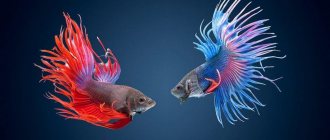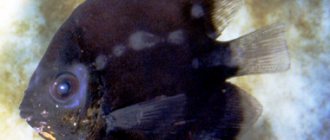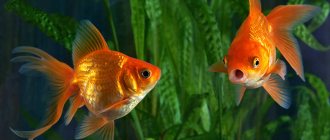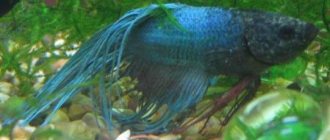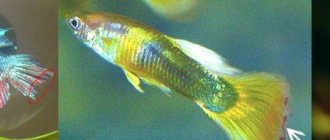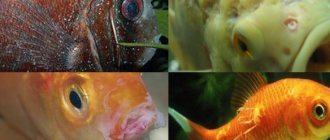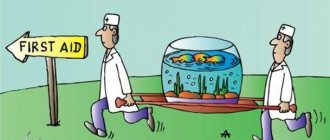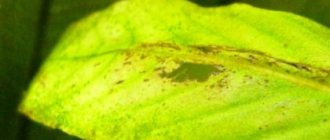The aquarium fish betta is a fascinating inhabitant of any artificial reservoir. However, they need good care and proper feeding. If these simple rules are not followed, the betta fish can become seriously ill and even die. Every fish owner should know what ailments these creatures are susceptible to and how to recognize and treat fin rot, because aquarium fish diseases are a serious matter and require immediate intervention.
Fin rot
A common cause of fin rot is bad water, which can happen due to poor-quality filter or siphon operation, overcrowding of the aquarium, or untimely cleaning. The disease is bacterial and is transmitted between fish. Externally, the fins look frayed, rotting, and you can see that they are stuck together. Additional symptoms include discoloration, sores on the body, and lethargic behavior.
Fin rot in betta fish is noticeable even in the early stages. Check your pet daily.
Without treatment, the cockerel will soon die. Having noticed the first symptoms of the disease, you must:
- Remove the specimen with a separate net and place it in a container with clean water suitable for keeping fish.
- Empty the aquarium completely, wash with hot water without soap, and clean the corners of accumulated dirt.
- Rinse the contents and soak in hot water for 10 minutes; place live plants in warm water. Next, everything is dried in air.
- To clean the soil, use the hottest water possible.
- A cleaned and dry aquarium is filled with dechlorinated or conditioned water at a temperature of 26-27 degrees.
- The water filter is washed to remove mucus in aquarium water.
- Before releasing the fish, you need to measure the pH level; its value should be between 7-8. Ammonia, nitrites and nitrates should not exceed 40 parts per million (pmm).
- Having settled the inhabitants of the aquarium, including the sick betta fish, an antibacterial or antifungal drug, for example AntiBak, is added to the water.
If cleansing does not bring results, the individual feels worse after a few days, lies on the bottom and practically does not swim, use antibacterial agents:
- Biomycin;
- Streptocide;
- Malachite green and others.
The drugs are used according to the instructions, the duration of therapy is 60 days. You need to choose products without organic dyes, they are harmful to many types of fish. For the purpose of prevention, you can add 1-2 drops of tea tree oil or table salt 20g/4l to the water.
It is important to provide your pets with oxygen after treatment; for this, an air compressor or air nebulizer is installed.
Treatment
The development of the disease depends on the rate of transmission of parasites from sick fish to healthy individuals. Each ciliate produces about 2,000 daughter cells, which then seek out the next host. The infection cycle takes only 3-4 days.
It is better not to remove affected fish, but to treat the entire aquarium at once. Before applying the drug, you need to replace some of the water, clean the soil and rinse the decorations and plants. This will reduce the level of ammonia in the water and help the fish tolerate the procedures more easily.
To treat ichthyophthyriosis, drugs based on malachite green with formalin and furatsilin are used (Antipar, Sera Omnisan + Mycopur, Tetra Contralck).
It is necessary to accurately calculate the dosage of the drug used and in no case mix different drugs. They are quite toxic and greatly affect water parameters. Therefore, before each application of the drug, 1/3 of the water must be replaced.
It is necessary to provide additional oxygen access and limit fish feeding. After all the white spots on your pets have disappeared, you need to remove the remaining drug. A massive water change will help with this: twice a day, 1/3 of the volume.
Ichthyophthiriasis
The causative agent of ichthyophthirosis or “white semolina” in cockerels is a ciliated ciliate. Parasites can come from live food, equipment or a sick individual. The cause of the disease is also considered to be stress due to low temperature and hard water. Signs of the disease can be detected approximately 4-6 days after infection, the pathology manifests itself:
- white coating on the skin, gills, fins, resembling semolina in appearance;
- rapid breathing;
- loss of appetite;
- friction against plants and other objects;
- lack of response to stimuli.
Semolina is a telling name for ichthyophthyriosis. It's easy to identify.
Ichthyophthiriasis is not considered a serious disease; to treat it, the infected cockerel is placed in a separate container, where the water temperature should be 30 degrees. Therapy is carried out: Malachite green, Bicillin-5, Antipar. Salt is added to the same water.
The fish doesn't eat
A hunger strike can be caused by:
- Inappropriate food, abrupt change of food.
- If the food particles are too large, the betta cannot swallow them. If your pet tries to take food but spits it out, there may be something stuck in the throat. The fish needs to be examined, preferably by a specialist.
- Overeating, constipation. If there is no excrement for a healthy adult, it is enough to fast for a couple of days. Juveniles and individuals with low immunity will need treatment.
- The period of spawning and caring for fry.
- Diseases:
These reasons are safe, temporary and easily removable. For example, replace dry food with live food or vice versa.
— Ichthyophthiriasis (semolina).
- Trichodinosis. The reason is ciliate parasites. Treat with malachite baths with aeration at elevated temperatures.
— Mycobacteriosis (tuberculosis). It develops in poor conditions and is aggravated by low immunity. Antibiotics are used for treatment.
Exophthalmia
If your bettas have a bulging or swollen eye, the water should be tested for nitrite, nitrate and ammonia. Inflated values require a partial change of fluid at the same temperature, so as not to cause stress and even greater protrusion.
Bug eyes in a cockerel are not a disease, but a symptom.
The cause of the disease is also considered to be an inappropriate amount of pH in the water and hardness; other factors are:
Mycobacteriosis
Therapy for “fish tuberculosis” is carried out with antibiotics, it is quite long, and after that it is necessary to take vitamins. The eyes of a cured cockerel do not return to place, it becomes unsuitable for procreation, medications only prolong life.
Aeromonosis, pseudomonosis, viral infection
All these diseases have similar symptoms: the appearance of red spots, bulging eyes, ruffled scales, ascites. Treatment is carried out with the drug Antibak-250, its effectiveness is high at the stage of bulging eyes, further therapy is practically pointless.
Protozoal or helminthic infestations
The choice of medication depends on the type of worm. Helminthiasis is eliminated by Azinox, Biltricide, Praziquantel. If necessary, medications for betta fish can be replaced with medications from a regular or veterinary pharmacy.
Cockerel fish species
Cockerels, despite their diversity, are representatives of one species - “Betta splendens”. The types differ in color, shape and length of fins. Based on color, they are classified into single-color, two-color, and multi-color.
According to the shape of the tail - poster (short tail), poster-crescent, poster crown-tail, veil-tail, crown-tail, comb-tail, shovel-tail, half-moon, waxing moon, triangle-tail, half-sun, double-tail, rose-tail, dumbo.
To date, 70 species of cockerels (Betta splendes) have been bred.
Dropsy
Ascites is caused by metabolic disorders, improper feeding, Ichthyosporidium fungus, bacterial and viral infection.
With dropsy, the body swells, the scales become ruffled, and bruises become visible underneath.
In addition to a bloated abdomen, loss of appetite and lethargy, external signs of dropsy in males include:
- ruffled scales;
- redness on the belly or fins;
- ulcerative lesions;
- bruising;
- long white feces;
- rapid breathing;
- bulging eyes and lightening of the gills;
- fluid accumulated in the organs, leading to discoloration.
Basically, dropsy leads to the death of betta fish. You can try to cure the initial stages of the disease using oral medications: Sera bakto tabs, Sera baktopur direct, Sera cyprinopur, Furan-2, Sera ectopur. The water temperature should be 26-28 degrees.
If therapy is unsuccessful, the cockerels are killed, the aquarium and its contents are disinfected.
Stomach is swollen
- The most common explanation is overeating. Feed 3 times a day in recommended portions. Live food - no more than three bloodworms per feeding.
- An early sign of dropsy.
- Penetration of a tapeworm into the body.
- Tumor. Unfortunately, there is no cure, especially at a later stage.
- Vibriosis. A bacterial infection more common in salted aquariums. Treated with antibiotics.
Oodiniosis
The disease in males is provoked by poor quality care, hypothermia, and infection from other individuals. The main manifestation of oodinosis is the presence of a yellow coating on the body; other signs include:
- breaking and ruffled scales;
- paleness;
- rapid breathing;
- drooping and stuck together fins.
Oodinosis or corduroy disease. Over time, plaque covers the entire body of the fish.
Therapy for “corduroy disease” can be carried out: Antipar, Ichthyof, Formamed, Seraoodinopur water condenser. The drugs are used for all betta fish, even if one is sick, otherwise they will infect each other. The aquarium and accessories are disinfected. During the quarantine period, the water temperature is increased.
Aquarium fish Cockerel compatibility with other fish
The Male Betta is not compatible with other male Bettas due to its aggressive nature. Males get along with females without problems. And females can get along with other females of their species without any problems.
As practice shows, bettas, due to their aggressiveness, get along well with all peaceful species of aquarium fish in a common aquarium.
Sometimes they can attack male Guppies because of their long fin, mistaking him for one of their own. Long fins, the male Cockerel perceives the Cockerel as another male and can show aggression towards this fish.
It is not recommended to live with predatory fish.
Columnaria
The causes of the disease are overpopulation with fish, increased organic content, and untimely supply of feed. “Mouth fungus” manifests itself as an increase in the area under the gills, without ruffling of scales and protruding eyes as with ascites, and also:
- lethargy;
- secrecy;
- dark coating on the gills;
- the appearance of plaque on the fins and in the mouth area;
- deformation of the muzzle;
- lack of response to stimuli;
- fin compression;
- unnatural way of swimming with worm-like movements;
- refusal to feed, weight loss and the appearance of a hump due to a sunken abdomen;
- blurred eyes.
Columnaria has many symptoms.
The disease is not always easy to diagnose; there may be no clear signs, but the bacteria will actively multiply in the general aquarium. In the most severe case, the inhabitants die within 2 days; if the betta fish gets a mild form of the disease, 1-2 fish will die per month.
Columnaria blight is differentiated from saprolegnia by external signs. The latter has mold, similar to cotton wool, in which threads are visible. In the first case, the coating is homogeneous and velvety. What distinguishes it from helminthic infestations is its localization; with columnarium, only the fins and mouth are affected, the fish do not itch on equipment and plants. It is also important not to confuse abdominal distension with ascites, pregnancy and obesity, or the pseudotuberculosis form with tuberculosis.
To treat cockerels, antibiotics of the tetracycline group are used, others are possible, but in practice, the effect will not be sufficient. Suitable pharmaceutical products are:
- Tetracycline;
- Metacycline;
- Doxycycline.
In epidemic situations, a combination of Doxycillin (2 capsules/100 l) and Beseptol-480 (1.5 tablets/100 l) can be used. In severe cases, the dosage of the first can be increased up to 2 times, the rate of the second remedy remains the same.
Every day you need to replace 30% of the water and add medications at the rate of 1 capsule/100 l of Doxacillin and 0.5 tablets/100 l of Biseptol-480. The gill form generally leads to death, but you can try to prolong the life of the cockerels by first bathing in a concentrated salt liquid of 5-10 g/1 l with a gradual increase in the amount of salt.
On the third day of treatment for the disease, you can use means that promote the recovery process. For this purpose, propolis extract 1 tsp/100 l is suitable, which is added every other day. Bettas may react by scratching, but this is normal and usually goes away within half an hour. After treatment, it is necessary to start biofiltration or it is necessary to ensure that ammonia and nitrates do not appear in the liquid.
During therapy for 5-7 days, the lights in the aquarium should be turned off and the windows closed from sunlight. It is turned on for 2-3 hours a day before feeding and changing water, so as not to destroy the vegetation.
Treatment of ichthyophthirius in fish, position of an ichthyopathologist
Ichthyophthirius, semolina, white spot disease, ichthyus... Who is he? Let's take a closer look:
Here he is, the hero of today's story.
My dream of getting enough sleep today is not destined to come true. Early in the morning a phone call: “Ver, your platies in your first aquarium are covered with white dots, what should you do?” - I open my eyes, trying to pretend that I was already awake: - Are there many dots? - Well, there are 30-40 pieces, the tails are all dotted, especially on the red ones... - Where were you when there were 1-2 dots, - at least don’t go away for the weekend - well, pour Kostapur and Mycopur, and I’ll come I'll take a look the day after tomorrow.
I hang up the phone and then I understand that the platies have just been treated for bacteria, and their water is salty, there is a tablespoon of salt per 10 liters of water. But even 20 years ago, salt was one of the main methods of treating ichthyophthyriosis.
The day after tomorrow it only got worse, the disk platies were covered with dots, like a carpet. The already classic regimen in my practice - Sera Costapur (in full dose every other day) + Sera mycopur (in half dose, daily) - failed again. I made a change and added Sera Costapur + furazolidone at the rate of 1 tablet of 50 mg per 15 liters of water. Furazolidone is a nitrofuran drug; most bacteria and protozoa are sensitive to it. It’s a good product, but I use it only in extreme cases, it destroys the microflora of the aquarium and for about two weeks the water turns the color of, excuse me, urine, and looks extremely unpresentable at the sales counter.
Two days have passed. The result is zero. It's getting worse again. The disk platies began to fall to the bottom; there was no living space on the body. I understand that continuing treatment with furazolidone is also useless. I'm making a massive change again. The last resort left is copper. I take the cheap drug “Formamed” and fill it up. After a day, there were clearly fewer spots, and the fish began to recover. Copper is strong, but not the best option for a home aquarium. Destructive for invertebrates (snails, shrimp, etc.), algae, beneficial microflora of the aquarium, and with minimal overdoses also for fish and plants.
This is a recovering fish; just yesterday there were twice as many points, but even now it is not a fact that it will survive.
This is how diseases evolve along with progress in pharmacology. I often hear from my colleagues: “Semolina”? So I raise the temperature and pour a little blue. - And how does it help? - Well, yes... There were, however, cases when the entire aquarium died and nothing helped...
We once had a supplier who claimed that if you always keep fish at 30°C, it will never get sick with ichthyophthirius. However, as practice has shown, at such temperatures the fish lose weight due to the acceleration of metabolism, but continue to get sick. Not long ago, discus fish, whose temperature is always 30-31°C, became ill.
Do not believe in fairy tales that ichthyophthirius can only be introduced with new fish and live food. Under unfavorable conditions, the cysts fall asleep and are able to remain viable for a long time. They remain in the ground, on the body of the fish. There is evidence that living ichthyophthirius cysts were found even in tap water! Just take it for granted - it is always there in your aquarium. What to do?
First: the best treatment is prevention. In our case, control of the most important water parameters, proper feeding, compliance with housing conditions (schooling fish are kept in schools, everyone has enough volume and shelter), all this is the prevention of stressful phenomena, and stress is a decrease in immunity and a direct path to disease.
Second: daily inspection. In most cases, 1-2 points found in time are treated very easily. Whereas an advanced disease is practically incurable. Third: buying new fish. Be careful what you buy. Ideally, find out when the store has a delivery, see what new has arrived at the store and then come back after 4-5 days, the fish will have acclimatized by this time and if, due to the stress of transportation, it has become ill with ichthyophthyriosis, you will see it. Inspect each fish, also pay attention to the condition of the aquarium (poor living conditions mean stress, see point 1), and the presence of medications in the water.
Fourth: choice of treatment method. If, nevertheless, one day a disease visits your aquarium (and as practice shows, sooner or later every aquarist faces this problem) - you need to choose the right treatment.
1. If you see 2-3 dots, they are obvious, large (about 0.5-1 mm). You can raise the temperature by 2-3 degrees. Add salt to the water at the rate of 1 tbsp. for 10 liters of water. The salt dissolves in the jar; you cannot pour all the salt into the water at once, in 3-4 doses with an interval of 15 minutes. Remember that not all fish can be salted. Most catfish cannot tolerate salt; Sumatran and mossy barbs also do not like it. You should not salt aquariums with plants. Increase aeration. Malachite green (“Malachite green”, “Ichthyophorus”, “Zoomir”, Sera Costapur according to instructions). Before applying the drug, change 30-50% of the water (with the addition of salt to the original concentration). Cleaning your aquarium before adding dyes (be it malachite green, methylene blue, acriflavine or anything else) is a must! If there is an excess of organic matter, the dyes are quickly inactivated. Malachite green is applied once every two days in full dose.
2. If you see many very small, barely noticeable dots (and in general if the disease is already advanced) - do not raise the temperature, tropical forms of ichthyophthirius are activated at a temperature of 30-32 ° C, raising the temperature will kill the fish.
3. Treatment with short-term baths is ineffective, since the parasite is located under the epithelium and the medicine cannot reach it. The main impact is on the strays, and they swim freely throughout the aquarium.
4. I have already said that one of the best remedies for ichthyophthyriasis is malachite green, I personally use a drug based on it - Sera Costapur. It works much better in combination with Sera mycopur (at half the dosage). Tested - Sera Costapur does not kill plants and invertebrates, used in herbalists and shrimp farmers. But lately malachite green has been acting worse and worse.
5. An even stronger combination (available to the general public) is Sera Costapur (according to instructions every other day) + furazolidone (1 tablet per 15 liters of water). Furazolidone kills not only ichthyophthirius, but also plants and beneficial flora.
6. I have encountered copper preparations more than once - they help even when nothing else helps. Copper is extremely toxic to invertebrates; the slightest overdose can kill fish. I use Zoomir’s “Formamed”, purely empirically - it poisons fish less than pure copper sulfate (even capricious and treated-over-treated fish can withstand it), and it works no worse.
Vera Dudina Veterinarian, ichthyopathologist, Moscow
ADDITIONAL NOTE ABOUT TREATING FISH.
This note outlines brief postulates and thoughts on treating fish for beginners and aquarium hobbyists. Read them carefully, they will help you and your pets.
1. Assess the feasibility of treatment. Sometimes the cost of medicine (500 rubles) is several times higher than the cost of a fish (neon 50 rubles). No matter how cruel it may sound, there is common sense in what has been said. We are only FOR it if you are responsible for those you have tamed and treat the fish as a family member and all that. But no one has canceled the concepts of rationality and expediency.
2. Before any treatment, 1/4-1/2 of the water is replaced with fresh water. This is done in order to minimize the concentrations of nitrogenous compounds - poisons NH3/ NH4, NO2, NO3 . It is important to understand that often these poisons are the root cause of fish diseases. The fish are poisoned by them, their immunity drops and the pathogenic flora calmly attacks the weakened body.
3. In addition, it is advisable to always have on hand drop tests for the above poisons + PO4 phosphates . For what? Firstly, to know the concentrations and not allow them to be exceeded. Secondly, it is not always necessary to completely zero out nitrate (NO3) and phosphate (PO4), for example, in a planted aquarium, zeroing them out will lead to additional problems with the plants, because Nitrate and phosphate are the main plant nutrients. Thirdly, the tests themselves allow not only to monitor the situation and understand the root cause, but also to control the situation before, during and after treatment.
Remember - you can’t administer medications when nitrogen and phosphate levels are high! By doing so, you will only aggravate the situation, since in addition to the poisons you will also add drugs that both heal and destroy. That is, they have not only positive properties, but also negative ones. Remember that any medicine is not a panacea, not a magic pill.
What tests to use? At your discretion, but preferably in drops and not in strips, because... drip ones are more accurate. In principle, take whatever tests you find, for example, Tetra tests , which are certainly available in every offline store. tests from VladOx at retail , if time is of the essence or you want to take tests for the future, then our recommendation is UHE tests (sold only online), also domestic, also inexpensive. Each of the above tests has its own specifics, incl. look and think for yourself. The note is not about tests, but about the treatment of fish.
Let's move on.
4. How, with what and for what to treat? Any forum discussions about fish disease are fortune telling on coffee grounds. Since an ichthyoptologist can make an accurate diagnosis after scraping the fish and analyzing it under a microscope, or even after dissecting the fish. So, something like this, friends. Our position on the mechanism of home treatment is described in this article , take a look. The bottom line is briefly: if the symptoms of the disease are obvious, as, for example, with ichthyophthyriosis or hexamitosis , then we treat with drugs and according to the treatment regimen for this disease. If the symptoms are not obvious, we treat comprehensively.
Complex medications, for example, Tetra Contralck (contains malachite green and formaldehyde) help well against invasion (parasites - ichthyphothyriasis, oodinosis, costiosis, etc.), but also have a detrimental effect on other pathogenic flora. No, Tetra Contralk, there are other complex medicines.
Moreover, when we talk about “complex treatment”, it is advisable to understand and analyze what we are taking and from what. For example, the drug Tetra General Tonic is:
Ethacridine lactate - 836.0 mg Acriflavine - 160.2 mg Methylene blue - 56.44 mg 9-aminoacridine * HCI * H2O - 28.20 mg
It’s not there, look for its components. And in general, it is advisable to collect an “Aquarium First Aid Kit” and keep it always at hand. Let's say there are Medosovsky-Vladoksovsky domestic monomedicines.
Subscribe to our YouTube channel so you don't miss anything
They took them, and, in fact, received the components of Tetra General Tonic. Silva please, gentlemen.
Moreover, having gained experience, you can generally master it and switch to treatment with pharmaceutical drugs .
5. The treatment regimen itself is described in the instructions. There is no special wisdom here. Please note that during treatment it is advisable to increase the aeration of the aquarium and not keep the aquarium lighting constantly on. Many drugs disintegrate quickly when exposed to light.
Of course, there should not be any sorbents (charcoal, zeolite) in the filter; you cannot use water conditioners, such as Tetra AquaSafe or Sera Akutan , they bind drugs.
6. After treatment, do not forget that many medications disrupt the biological balance in the aquarium, that is, they kill both pathogenic and beneficial flora. starter preparations and other measures aimed at restoring the nitrogen cycle in the aquarium will come to your aid
LET'S SUMMARY . Fish don't just get sick. Negative conditions of detention are the root cause. Either you bought already stunted fish, or negative conditions have developed in your aquarium. Any treatment begins first of all with finding and eliminating the root cause. Next, a decision is made on the treatment mechanism. During the treatment period, special attention is paid to symptoms (regression, progress). Please note that regression of the disease may not occur in 2-3 days. After treatment, we do everything so that the aquarium begins to work as a single, holistic and healthy mechanism.
Mycobacteriosis
The causative agent of the disease in males is the gram-positive bacillus Micobacterium piscum. It affects internal organs, and many individuals become ill at the same time. The microorganism can come from food, plants and soil from water bodies, through contaminated equipment and water from another aquarium, or through fish.
Mycobacteriosis is also known as fish tuberculosis.
Symptoms include:
- lethargy;
- drooping tail;
- refusal of food;
- the fish lying on the bottom with its head and tail raised;
- exhaustion;
- loss of scales and formation of ulcers;
- black spots on the body;
- bulging eyes;
- darkening of the eyes.
The duration of the disease ranges from several days to several months. Then the cockerel fish dies. Infected individuals are destroyed, equipment is disinfected with a solution of 3% chloramine or 5% bleach. You can try to treat individuals, but the results are rarely positive. Therapy is carried out in a separate container. Doxycycline or Monocycline 30 mg/10 l is added to the water for 10 days. You can also use Oxytetracycline 150 mg/10 l, Tetracycline 0.2 g/10 l. The course is repeated after 30 days. In an aquarium with sick cockerels, ozonation is carried out.
One feeding per day should contain Rifampicin or Kanamycin. Bloodworms are soaked in a solution of the latter for 30-60 minutes at a dosage of 1g/100ml of liquid. The same agents are poured into water. If an individual refuses food, the dosage of Kanamycin for water in this case is 3g/100l, Rifampicin 600mg/100l.
Symptoms of the disease
The main symptom that indicates the onset of the disease is white dots on the pet’s body. At first they appear in small quantities, but with each subsequent day they become more numerous. The dots are so small that they can be compared to semolina, which is how the disease got its name. Ichthyophthyriosis bacteria enter the common pool with water, food, and soil, after which they attach to the scales of the inhabitants.
Semolina is tubercles, not white spots. Parasites are able to escape through these tubercles. The following symptoms of the disease are distinguished:
- pets begin to behave restlessly, rubbing their bodies against various objects in the aquarium, soil and plants;
- if the internal organs are damaged, then the fish become indifferent to surrounding stimuli;
- pets lose their appetite;
- they often float on the surface, swallowing air;
- eye damage can lead to blindness;
- the body turns pale and becomes covered with a white coating.
In this video you will learn more about semolina treatment:
If measures are not taken urgently, the fish will die due to oxygen starvation and damage to a large area of the epithelium.
Viremia (rubella of cyprinids)
The disease, the causative agent of which is a virus from the group of rhabdoviruses, has a seasonality; it often appears in the spring.
The causes are considered to be poisoning with nitrogenous compounds and infection from other individuals. The appearance of hemorrhages is not immediately detected on cockerels of the same color, and they will also not be visible on blue, violet, lilac, turquoise, and emerald colors. Rubella can be diagnosed externally on white fish. Localization of spots appears near the head or chest. Signs also include:
- swelling of the body;
- ruffled scales;
- lethargy and loss of appetite;
- bulging eyes of one and two eyes.
After opening the betta fish, there is a noticeable accumulation of yellow liquid, which may contain blood. The color of the liver is uneven, it may be pale and have bloody spots in places. Treatment of rubella is carried out with the drug Sera Bactopur direct; the liquid must first be tested for ammonia, nitrites and nitrates.
Why shouldn't you overfeed your fish?
The most important reason why you should not overfeed fish is harm to health. When overfeeding, it is very easy to damage any internal organs of the fish and the fish may die. This occurs due to the fact that a large amount of food enters the body and the fish’s organs can literally burst.
Most aquarium fish do not feel full and will eat only as much as is given to them.
This is especially true for viviparous fish. Personally, in my practice, there were cases when a fish’s belly burst right before our eyes and the fish died.
Injuries
Cockerels can get injured on sharp stones, decorations, or in a fight.
A minor injury to the betta will heal on its own, provided the water quality in the aquarium is good. If your pet is seriously injured, your help is needed.
To avoid this, you need to inspect the contents and also observe how your neighbors behave. Male bettas are often aggressive towards each other and other individuals. Therefore, it is not recommended to keep male fish together. Females are more peaceful, and conflicts occur much less frequently among them. Externally, injuries are identified by torn tails, fins and scales. If the damage is not severe, the betta fish should gradually recover on its own. To ensure rapid healing of mechanical damage, use:
- Methylene blue;
- Melafix;
- Black tea;
- Peat extract;
- Table salt 3g/1l.
Severe wounds are smeared with antibiotic ointment or a weak iodine solution. The cockerel can also be kept in a weak solution of furatsilin, manganese or other antiseptic. In case of poor chemical composition and hard water, wounds can become infected, which is why they do not heal for a long time or are affected by fungi.
It is important to distinguish mechanical damage from diseases that cause ulcers to appear on the body. To treat the latter, cleanliness, rest and treatment are not enough; the use of antibiotic baths will be required, depending on the pathogen.
Costiosis in cockerels
Costiosis is a very dangerous disease that will almost certainly lead to the death of your pet.
The disease is caused by a parasite of the flagellated species Ichtyobodo necatrix. It clings to the fish with its flagella. This causes damage to the gills and skin.
It can occur when introducing a new pet that has not passed quarantine, or when using untreated soil or an unwashed plant.
As a result of exposure to this parasite, the skin is damaged and mucus is produced heavily.
The damaged fish begins to itch against the glass wall of the aquarium or against hard objects, loses appetite, and the body is covered with gray-blue spots (like a veil). The gills are covered in a thick layer of mucus, the fins stick together. A fish swims turning on its side. Most often the pet dies.
If a disease is detected, you must urgently move the cockerel to a separate aquarium, dissolving 5 crystals of potassium permanganate there.
For baths, use methylene blue, trypaflavin, bicillin.
The eggs of the parasite are resistant to external influences. To prevent the recurrence of bone disease, treatment should be carried out in quarantine.
Prevention
The likelihood of all diseases can be reduced only by proper care of the aquarium and fish, which includes the following rules:
- Wash your hands with soap before and after working with pets.
- In different aquariums the same equipment is not used, or it is disinfected after each use.
- The inhabitants should not be overfed, despite the fact that they seem hungry after eating the norm. Live food must be of high quality.
- To avoid hypothermia, it is necessary to monitor the temperature of the liquid.
- It is important to observe not only the compatibility of the fish, but also not to overpopulate it.
- You cannot keep plants that you brought yourself from bodies of water.
- New soil must be disinfected before laying.
- Pets should be allowed to spawn and their health should be maintained with vitamins.
- New individuals, especially foreign ones, are kept in a separate container for 1 - 3 months. At this time, the pet's condition is carefully monitored.
One third of the water needs regular replacement; the frequency of the procedure is determined by the capacity. Periodically clean the bottom, decorative elements, and plants. Leftover food should be removed after each meal.
A healthy fish is the pride and joy of a caring owner.
As aquarists have noted, the betta is a fairly strong and hardy fish that fights for its life in any pathology, however, breeders must comply with all care conditions to ensure it remains healthy.
Other interesting articles
- Aquarium fish-predators Most aquarium fish lovers prefer herbivorous species. They do not require special care, almost never...
- Aquarium fish in a pond After arranging a pond, almost every person has a desire to revive it by adding fish there. Exists…
- What fish can live without aeration, air in the aquarium? What fish can survive without oxygen and filtration? No living creature can live without...
Main reasons
Manka fish disease can attack different types of fish, so therapy must be carried out in the entire aquarium. It has been proven that a pet can get ichthyophthyriasis once in its life. Then immunity is developed.
Viviparous individuals are most prone to the disease. As for humans, this bacterium is not scary for them. The following causes of semolina infection are identified:
- live food that was brought from a tropical area (it is quite difficult to remove ciliates from plants);
- a new resident has appeared in an artificial reservoir;
- contaminated soil;
- poor-quality cleaning of the reservoir (you should regularly remove plaque from the aquarium and clean the filter);
- the appearance of new fish in the aquarium;
- sudden changes in temperature;
- stressful situations for fish.
When the infection occurs at the first stage and there are no white tubercles yet, it is impossible to see it.

